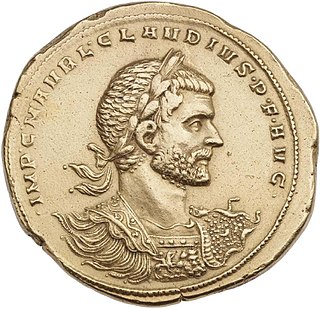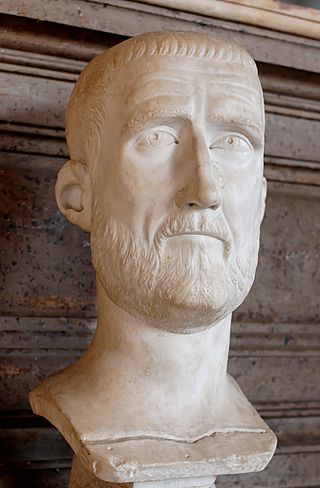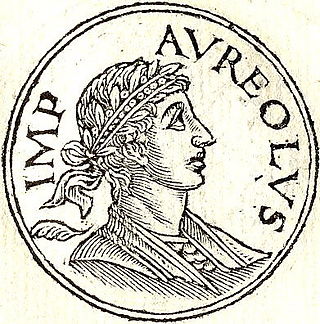
Publius Licinius Egnatius Gallienus was Roman emperor with his father Valerian from 253 to 260 and alone from 260 to 268. He ruled during the Crisis of the Third Century that nearly caused the collapse of the empire. He won numerous military victories against usurpers and Germanic tribes, but was unable to prevent the secession of important provinces. His 15-year reign was the longest in half a century.
The 270s decade ran from January 1, 270, to December 31, 279.
The 260s decade ran from January 1, 260, to December 31, 269.

Year 268 (CCLXVIII) was a leap year starting on Wednesday of the Julian calendar. At the time, it was known as the Year of the Consulship of Paternus and Egnatius. The denomination 268 for this year has been used since the early medieval period when the Anno Domini calendar era became the prevalent method in Europe for naming years.

Year 269 (CCLXIX) was a common year starting on Friday of the Julian calendar. At the time, it was known as the Year of the Consulship of Claudius and Paternus. The denomination 269 for this year has been used since the early medieval period, when the Anno Domini calendar era became the prevalent method in Europe for naming years.

Marcus Aurelius Claudius "Gothicus", also known as Claudius II, was Roman emperor from 268 to 270. During his reign he fought successfully against the Alemanni and decisively defeated the Goths at the Battle of Naissus. He died after succumbing to a "pestilence", possibly the Plague of Cyprian that had ravaged the provinces of the Empire.

Marcus Aurelius Probus was Roman emperor from 276 to 282. Probus was an active and successful general as well as a conscientious administrator, and in his reign of six years he secured prosperity for the inner provinces while withstanding repeated invasions of barbarian tribes on almost every sector of the frontier.

The Gallic Empire or the Gallic Roman Empire are names used in modern historiography for a breakaway part of the Roman Empire that functioned de facto as a separate state from 260 to 274. It originated during the Crisis of the Third Century, when a series of Roman military leaders and aristocrats declared themselves emperors and took control of Gaul and adjacent provinces without attempting to conquer Italy or otherwise seize the central Roman administrative apparatus.

Marcus Cassianius Latinius Postumus was a Roman commander of Batavian origin, who ruled as emperor of the splinter state of the Roman Empire known to modern historians as the Gallic Empire. The Roman army in Gaul threw off its allegiance to Gallienus around the year 260, and Postumus assumed the title and powers of Emperor in the provinces of Gaul, Germania, Britannia, and Hispania. He ruled for the better part of ten years before he was murdered by his own troops.

Marcus Aurelius Marius was emperor of the Gallic Empire in 269 following the assassination of Postumus.

Laelian, also incorrectly referred to as Lollianus and Aelianus, was a usurper against Postumus, the emperor of the Gallic Empire. His revolt lasted from approximately late February to early June 269.

Domitian II was a Roman soldier of the mid 3rd century who was acclaimed emperor, probably in northern Gaul in late 270 or early 271, and struck coins to advertise his elevation. It is now generally assumed that this man is to be equated with the Domitianus who is twice mentioned in the literary sources as a significant figure in the politics of the age, but on neither occasion as an outright contender for the Imperial throne.

Gaius Pius Esuvius Tetricus was the emperor of the Gallic Empire from 271 to 274 AD. He was originally the praeses (governor) of Gallia Aquitania and became emperor after the murder of Emperor Victorinus in 271, with the support of Victorinus's mother, Victoria. During his reign, he faced external pressure from Germanic raiders, who pillaged the eastern and northern parts of his empire, and the Roman Empire, from which the Gallic Empire had seceded. He also faced increasing internal pressure, which led him to declare his son, Tetricus II, caesar in 273 and possibly co-emperor in 274, although this is debated. The Roman emperor Aurelian invaded in 273 or 274, leading to the Battle of Châlons, at which Tetricus surrendered. Whether this capitulation was the result of a secret agreement between Tetricus and Aurelian or necessary after his defeat is debated. Aurelian spared Tetricus, and even made him a senator and corrector (governor) of Lucania et Bruttium. Tetricus died of natural causes a few years after 274.

Gaius Pius Esuvius Tetricus, better known as Tetricus II, was the son of Tetricus I, Emperor of the Gallic Empire from 271 to 274 AD.

Aureolus was a Roman military commander during the reign of Emperor Gallienus before he attempted to usurp the Roman Empire. After turning against Gallienus, Aureolus was killed during the political turmoil that surrounded the Emperor's assassination in a conspiracy orchestrated by his senior officers. Aureolus is known as one of the Thirty Tyrants and is referenced in ancient sources including the Historia Augusta, Zonaras' epitome and Zosimus' Historia Nova.
The Gallienus usurpers were the usurpers who claimed imperial power during the reign of Gallienus. The existence of usurpers during the Crisis of the Third Century was very common, and the high number of usurpers fought by Gallienus is due to his long rule; fifteen years being considered long by the standards of the 3rd century Roman Empire.

Victoria, also known as Victorina or Vitruvia, was a leader in the Roman breakaway realm known as the Gallic Empire in the late 3rd century. She was the mother of Victorinus, who ruled as Gallic Emperor until his assassination in 271. Afterwards, Victoria used her authority to stabilize the empire and select a successor. For a few weeks, Victorina was considered as de facto empress of Gaul, from the death of Victorinus to the accession of Tetricus I. She took the throne as the reigning monarch.
Julius Placidianus was a Roman general of the 3rd century. He was a professional soldier who advanced his career under Gallienus and survived into the age of Claudius II and Aurelian. Placidianus was consul in the year 273 as the posterior colleague of Marcus Claudius Tacitus, the future emperor. His life presented here is largely derived from L.L. Howe's history of the Praetorian Prefecture.
The Siege of Augustodunum Haeduorum took place in 269-270, Augustodunum. Victorinus had been declared emperor by the troops located at Augusta Treverorum in the fall of 269. However, only the provinces of Gaul, Germania and Britain recognised him.

The barbarian invasions of the third century (212-305) constituted an uninterrupted period of raids within the borders of the Roman Empire, conducted for purposes of plunder and booty by armed peoples belonging to populations gravitating along the northern frontiers: Picts, Caledonians, and Saxons in Britain; the Germanic tribes of Frisii, Saxons, Franks, Alemanni, Burgundians, Marcomanni, Quadi, Lugii, Vandals, Juthungi, Gepids and Goths, the Dacian tribes of the Carpi and the Sarmatian tribes of Iazyges, Roxolani and Alans, as well as Bastarnae, Scythians, Borani and Heruli along the Rhine-Danube rivers and the Black Sea.

















